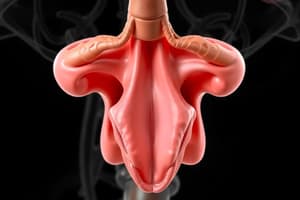Podcast
Questions and Answers
Which imaging modality is most suitable for evaluating bone structures in sellar masses?
Which imaging modality is most suitable for evaluating bone structures in sellar masses?
What is the primary purpose of performing Magnetic Resonance Imaging (MRI) focused on the hypophyseo-hypothalamic system?
What is the primary purpose of performing Magnetic Resonance Imaging (MRI) focused on the hypophyseo-hypothalamic system?
Which of the following is NOT a characteristic of a lactotroph adenoma on laboratory evaluation?
Which of the following is NOT a characteristic of a lactotroph adenoma on laboratory evaluation?
What is the primary role of a 1 mg Dexamethasone suppression test in the diagnosis of endocrine disorders?
What is the primary role of a 1 mg Dexamethasone suppression test in the diagnosis of endocrine disorders?
Signup and view all the answers
Which imaging modality is most useful for detecting intratumoral calcifications in sellar masses?
Which imaging modality is most useful for detecting intratumoral calcifications in sellar masses?
Signup and view all the answers
What is the primary indication for performing a Sella Turcica X-ray Lateral Incidence in the diagnosis of sellar masses?
What is the primary indication for performing a Sella Turcica X-ray Lateral Incidence in the diagnosis of sellar masses?
Signup and view all the answers
Which of the following is a characteristic of a pituitary adenoma on laboratory evaluation?
Which of the following is a characteristic of a pituitary adenoma on laboratory evaluation?
Signup and view all the answers
Which of the following imaging modalities is NOT commonly used in the diagnosis of sellar masses?
Which of the following imaging modalities is NOT commonly used in the diagnosis of sellar masses?
Signup and view all the answers
What is the primary purpose of performing an Oral Glucose Tolerance Test (OGTT) in the diagnosis of endocrine disorders?
What is the primary purpose of performing an Oral Glucose Tolerance Test (OGTT) in the diagnosis of endocrine disorders?
Signup and view all the answers
Which of the following is a characteristic of acromegaly on laboratory evaluation?
Which of the following is a characteristic of acromegaly on laboratory evaluation?
Signup and view all the answers
Study Notes
Neuro-ophthalmic Syndrome
- Chronic, persistent, progressive headache with retroorbital and bitemporal localization can occur due to pituitary macroadenoma, which can disappear when the sellar diaphragm is perforated, but reappears when intracranial hypertension develops.
- Acute headache accompanied by nausea, vomiting, and alteration of consciousness can occur due to sudden growth of pituitary as a consequence of infarction or hemorrhage inside a pituitary adenoma.
Visual Field Defects
- Optic chiasm syndrome with bitemporal hemianopia can occur due to compression of nasal optic fibers at the optic chiasm level.
- Other visual field defects can occur, such as scotomas, quadranopsies, uni- or bilateral sight loss, stasis, papillar edema, or retinal hemorrhages.
Cranial Nerve Compression
- Compression of the oculomotor nerve, palsy of IV, V, and VI cranial nerves can cause ptosis, diplopia, ophthalmoplegia, and facial numbness.
Other Symptoms
- Temporal lobe epilepsy (uncinate seizures) can occur due to parasellar extension of pituitary adenomas.
- Anosmia and personality disturbances can occur due to frontal lobe involvement.
- Hypothalamic compression can cause disturbances in temperature, sleep, appetite, or thirst regulation, and dysfunctions of the autonomous nervous system.
Incidentaloma
- A pituitary tumor mass can be discovered incidentally during a cranial imagistic exploration for other reasons, and is called an "incidentaloma".
Hypothalamic-Pituitary Gland Unit
- The hypothalamic-pituitary gland unit represents the paradigm of the interaction between the endocrine and nervous systems.
Anatomy
- The hypothalamus forms the floor and lateral walls of the third ventricle.
- The pituitary gland lies at the base of the skull in the sella turcica of the sphenoid bone.
- The pituitary gland is surrounded by dura mater and has an opening of 5 mm for the pituitary stalk in the diaphragma sellae.
Laboratory Investigations
- Laboratory investigations consist of plasma pituitary hormone levels determinations.
- Hormonal hypersecretion is caused only by pituitary adenomas.
- The demonstration of hormonal hypersecretion identifies the sellar mass as a pituitary adenoma and also identifies the type of adenoma.
Imagistic Investigations
- Magnetic resonance imaging (MRI) is the single best imaging procedure for most sellar masses.
- Computed tomography (CT) allows better visualization of bone structures.
- Positron emission tomography (PET), scintigraphy with radioactive octreotid (octreoscan), or SPECT (single photon-emission computed tomography) can also be used.
- Sella turcica X-ray lateral incidence can evidentiate the enlargement of the sella, wall erosion, double contour, dorsal wall verticalization, and clinoidal hypertrophy.
Studying That Suits You
Use AI to generate personalized quizzes and flashcards to suit your learning preferences.
Description
This quiz covers the symptoms and characteristics of pituitary macroadenoma, including chronic headache and neuro-ophthalmic syndrome. It also explores the effects of sudden growth and infarction on the pituitary gland.




